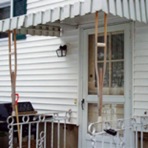Hi Everyone,
My knowledge of this stuff is pretty limited, so I thought I would run my battery backup ideas past some of you experts. Although we have had one 4 day power outage that is a real rarity. My plan is to cover two days of no power.
Machine Respironics BiPAP AutoSV.
Pressures: MinIPAP 7; MaxIPAP 20; EPAP 5. Average IPAP pressure is about 10.
Machine draws 3 Amps DC max.
Humidifier would be by-pass only.
I'm on oxygen supplement so want a battery like AGM or other sealed type.
I'm figuring that 3 amps x 8 hours = 24 Amp Hours (I realize the machine is probably drawing a lot less, but this should give me a large margin of safety.)
I don't want to move a heavy battery around in a power outage, so I was thinking if I got about a 50 AH deep discharge battery, I would draw it down 50% or less per night. The 50 AH range don't look too heavy to schlep. If I get two batteries, then I could recharge one each day and always have a ready spare.
I'll need the Respironics power cord which is unreasonably expensive plus the right smart charger.
Comments, suggestions, etc. would be appreciated,
Mr Capers
Battery backup plans - sound OK?
- timbalionguy
- Posts: 888
- Joined: Mon Apr 27, 2009 8:31 pm
- Location: Reno, NV
Re: Battery backup plans - sound OK?
Sounds like you are on the right track.
Since you know what you need in terms of battery capacity, I would give the most thought to the type and number of batteries. Personally, I would go for the single, bigger battery. AGM will probably give you the best capacity per pound in lead-acid, but a more conventional 'gel cell' type battery would be more economical. If weight is a serious concern, CPAP.com (and I am sure other places) have Li-ion batteries that offer the most power density per pound. They are priced accordingly.
If power is out, charging one battery while using the other is not practical, unless you have something like a solar panel or generator. And you would need a fairly good-size solar panel to reliably charge a battery that size in a day. Using two batteries has one advantage though; weight. You can carry these batteries one at a time as needed.
Personally, I would purchase my own 12 to 24 volt converter (they make laptop converters that will do this, for older laptops), or maybe even build one, but I realize this is not for everyone. If the voltage regulation is not critical, using two 12 volt batteries in series nominally gives you 24 volts. Total capacity would stay the same, as you have higher voltage and lower current flow. And there would be no loss from the DC-DC converter. Respironics would be able to advise you on power supply voltage tolerances.
The best charger IMHO, is a 'battery tender'. This is a 'slow charger' module designed to keep 12 volt lead acid batteries fully charged without overcharging them. Unless you need quicker charging, the $30 'wall wart' style is the most economical. Note that the battery tender should not be used when the battery is being discharged by a load such as your machine.
Personally, I use a 38 AH gel cell with my IntelliPAP. Gives me at least 2 nights' sue at 10-13 cm/H2O. Haven't tried at my current pressure. Since most outings I do require batteries for amateur radio or astronomy, I am usually carrying 2 or 3 of these batteries to power whatever I have with me. I use a universal connector for power (2 pin, .093 Molex, readily available at Radio Shack), so that most any load can be connected to any battery.
Since you know what you need in terms of battery capacity, I would give the most thought to the type and number of batteries. Personally, I would go for the single, bigger battery. AGM will probably give you the best capacity per pound in lead-acid, but a more conventional 'gel cell' type battery would be more economical. If weight is a serious concern, CPAP.com (and I am sure other places) have Li-ion batteries that offer the most power density per pound. They are priced accordingly.
If power is out, charging one battery while using the other is not practical, unless you have something like a solar panel or generator. And you would need a fairly good-size solar panel to reliably charge a battery that size in a day. Using two batteries has one advantage though; weight. You can carry these batteries one at a time as needed.
Personally, I would purchase my own 12 to 24 volt converter (they make laptop converters that will do this, for older laptops), or maybe even build one, but I realize this is not for everyone. If the voltage regulation is not critical, using two 12 volt batteries in series nominally gives you 24 volts. Total capacity would stay the same, as you have higher voltage and lower current flow. And there would be no loss from the DC-DC converter. Respironics would be able to advise you on power supply voltage tolerances.
The best charger IMHO, is a 'battery tender'. This is a 'slow charger' module designed to keep 12 volt lead acid batteries fully charged without overcharging them. Unless you need quicker charging, the $30 'wall wart' style is the most economical. Note that the battery tender should not be used when the battery is being discharged by a load such as your machine.
Personally, I use a 38 AH gel cell with my IntelliPAP. Gives me at least 2 nights' sue at 10-13 cm/H2O. Haven't tried at my current pressure. Since most outings I do require batteries for amateur radio or astronomy, I am usually carrying 2 or 3 of these batteries to power whatever I have with me. I use a universal connector for power (2 pin, .093 Molex, readily available at Radio Shack), so that most any load can be connected to any battery.
Lions can and do snore....
Re: Battery backup plans - sound OK?
The bad news is that even with a glass mat deep cycle battery, you shouldn't draw it down more than about 50% before recharging. If you do, you will shorten the life of the battery. This means that your 50 amp-hr AGM battery will yield just 25 amp-hrs before it must be recharged. At your predicted power draw of 3 amps, this means you'll get just one night out of that battery.
The good news is that it appears unlikely that your xpap will draw 3 amps continuously. I don't know how much it will draw but if it's under 1.5 amps, then you should be able to reliably get two 8-hour nights out of a 50 amp-hr battery.
If you look at cpap-com's backup batteries, there is a calculator to show how long their batteries will run. The calculator shows that CPAP.com's 6.6 amp-hr battery will run your xpap at your pressures for about 5.3 hours, which means that it's estimating your average power draw at just 1.25 amps assuming full discharge of the battery (their battery is a li-ion type and doesn't have the same discharge limitations as an AGM battery)
see this link:
https://www.cpap.com/cpap-machine/produ ... andbattery
I also suggest that you google "battery faq". There are a lot of online resources on this subject.
Another thing to keep in mind is that different batteries need different types of chargers. Use of the wrong type of charger will damage your battery. You can easily spend over $100 on a good quality AGM deep cycle battery charger. You should be able to find a decent charger for less than this, but it may be false economy to buy one that's too cheap.
My own backup battery is a size U1 wheelchair battery. It's of AGM type and yields just 17 useful amp-hours (ie. at 50% discharge). The battery weighs about 20 lbs. I have an automatic deep cycle battery charger matched to it. I plan is to use it for my xpap for just one night's use. Around here, power is rarely out for more than a couple of hours (knock on wood ).
The good news is that it appears unlikely that your xpap will draw 3 amps continuously. I don't know how much it will draw but if it's under 1.5 amps, then you should be able to reliably get two 8-hour nights out of a 50 amp-hr battery.
If you look at cpap-com's backup batteries, there is a calculator to show how long their batteries will run. The calculator shows that CPAP.com's 6.6 amp-hr battery will run your xpap at your pressures for about 5.3 hours, which means that it's estimating your average power draw at just 1.25 amps assuming full discharge of the battery (their battery is a li-ion type and doesn't have the same discharge limitations as an AGM battery)
see this link:
https://www.cpap.com/cpap-machine/produ ... andbattery
I also suggest that you google "battery faq". There are a lot of online resources on this subject.
Another thing to keep in mind is that different batteries need different types of chargers. Use of the wrong type of charger will damage your battery. You can easily spend over $100 on a good quality AGM deep cycle battery charger. You should be able to find a decent charger for less than this, but it may be false economy to buy one that's too cheap.
My own backup battery is a size U1 wheelchair battery. It's of AGM type and yields just 17 useful amp-hours (ie. at 50% discharge). The battery weighs about 20 lbs. I have an automatic deep cycle battery charger matched to it. I plan is to use it for my xpap for just one night's use. Around here, power is rarely out for more than a couple of hours (knock on wood ).
I'm workin' on it.
Re: Battery backup plans - sound OK?
I'm workin' on it.
Re: Battery backup plans - sound OK?
Hi to everyone,
First, thanks for your replies.
I was planning on only one night per battery. Charging would be either by regular utility power the following day, or, if the power is still out, by a generator - yet to be specified and bought. The one night limit was to keep the battery light enough to muscle it upstairs, out of the garage, etc. and to make the charge cycle shorter for the smaller battery - so I could recharge, even at a slow rate, in one day.
I'm not wanting to do a lot of lab rat or roll-your-own work on this. Since it is foreign territory to me, I think it is best left to those whose understanding is deeper/wider than mine.
What I mainly want to know is this: are any of my calculations wildly off base? Am I likely to destroy self or BiPAP? Have I left plenty of margin of error? To all the above, I think you've answered "Yes," you're OK. If I've got it all wrong, please let me know.
Many thanks, again, for the feedback,
Happy Naps
Mr Capers
First, thanks for your replies.
I was planning on only one night per battery. Charging would be either by regular utility power the following day, or, if the power is still out, by a generator - yet to be specified and bought. The one night limit was to keep the battery light enough to muscle it upstairs, out of the garage, etc. and to make the charge cycle shorter for the smaller battery - so I could recharge, even at a slow rate, in one day.
I'm not wanting to do a lot of lab rat or roll-your-own work on this. Since it is foreign territory to me, I think it is best left to those whose understanding is deeper/wider than mine.
What I mainly want to know is this: are any of my calculations wildly off base? Am I likely to destroy self or BiPAP? Have I left plenty of margin of error? To all the above, I think you've answered "Yes," you're OK. If I've got it all wrong, please let me know.
Many thanks, again, for the feedback,
Happy Naps
Mr Capers
- bearded_two
- Posts: 459
- Joined: Mon Aug 10, 2009 8:01 pm
Re: Battery backup plans - sound OK?
I am assuming that you are using the manufacturer's recommended 12 volt power cord.
It sounds reasonable to me; your power draw estimate sounds a bit conservative, and conservative power draw estimates are good. My guess is that your BiPAP will actually draw between 1.5 and 2 Amps, so figuring 3 Amps is reasonable. I would add a cheap digital volt meter (a DVM that will measure AC and DC volts, resistance, and can measure at least 5 Amps) to your shopping list, it can be used to check your battery voltage and to check your BiPAP's current draw.
You mentioned that you had O2 equipment; do you plan to use the battery to power any O2 equipment? I also wondered how many nights you expected to use the battery without recharging, You had used 24 hours in your calculations, but you mentioned recharging it daily. In areas that are not prone to longer power outages, I would size my battery to <b>at least</b> two nights.
I would calculate 2 Amps x 8 hours = 16 Ah per night. Two nights would be 32 Ah and your 50 Ah AGM battery will handle that without any problems.
A third night would be 48 Ah, which could discharge your battery deeply enough to shorten it's life. There is a tradeoff, it may be worth it to you to potentially shorten the life of your battery to get another night of CPAP during a snow storm.
You can use your DVM to more closely estimate your actual power draw before you need the battery and you can use your DVM to check the battery voltage to see if it is being properly charged.
It sounds reasonable to me; your power draw estimate sounds a bit conservative, and conservative power draw estimates are good. My guess is that your BiPAP will actually draw between 1.5 and 2 Amps, so figuring 3 Amps is reasonable. I would add a cheap digital volt meter (a DVM that will measure AC and DC volts, resistance, and can measure at least 5 Amps) to your shopping list, it can be used to check your battery voltage and to check your BiPAP's current draw.
You mentioned that you had O2 equipment; do you plan to use the battery to power any O2 equipment? I also wondered how many nights you expected to use the battery without recharging, You had used 24 hours in your calculations, but you mentioned recharging it daily. In areas that are not prone to longer power outages, I would size my battery to <b>at least</b> two nights.
I would calculate 2 Amps x 8 hours = 16 Ah per night. Two nights would be 32 Ah and your 50 Ah AGM battery will handle that without any problems.
A third night would be 48 Ah, which could discharge your battery deeply enough to shorten it's life. There is a tradeoff, it may be worth it to you to potentially shorten the life of your battery to get another night of CPAP during a snow storm.
You can use your DVM to more closely estimate your actual power draw before you need the battery and you can use your DVM to check the battery voltage to see if it is being properly charged.











